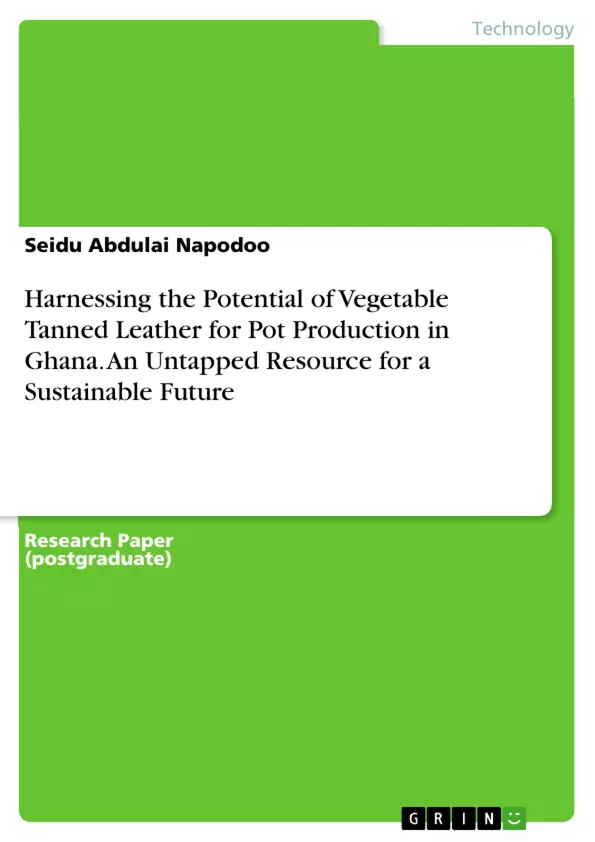Aiming to pioneer a revolution in the Ghanaian pottery industry, this study explores the largely untapped potential of vegetable tanned leather for pot production, a practice traditionally dominated by clay, cement, and metal materials.
The focus is on manipulating this durable and flexible material - indigenous tanned leather - to create pots that offer a distinctive blend of functionality and aesthetic appeal. Through a qualitative research approach involving in-depth interviews and observations, this study engaged with a diverse group of respondents from the Tamale Metropolis - including producers, sellers, users, and leather studies experts. The findings underscore the effectiveness of indigenous leather as an alternative material for contemporary pot production, heralding a wealth of untapped opportunities in Ghana's leatherwork industry. The study offers a strong case for reconceptualizing leather's conventional uses in the production of items such as bags, sandals, and footrests, to include pot production. This paradigm shift is set to stimulate human resource development, promote sustainable practices, and drive innovation in the country's pottery sector.
Inhaltsverzeichnis (Table of Contents)
- ABSTRACT
- INTRODUCTION
- METHODOLOGY
- Preparing the leather for Modeling
- PROCEDURES
- RESULTS
- DISCUSSION
- CONCLUSION
- REFERENCES
Zielsetzung und Themenschwerpunkte (Objectives and Key Themes)
This study investigates the potential of vegetable tanned leather as an alternative material for the production of pots in Ghana. The research explores the manipulation of indigenous leather to create functional and aesthetically pleasing pots, aiming to provide an alternative to traditional materials like clay, cement, and metals.
- Exploring the feasibility of using vegetable tanned leather for pot production.
- Evaluating the effectiveness of leather as a substitute material for traditional pottery materials.
- Investigating the properties of leather that make it suitable for pot production.
- Analyzing the cultural significance of pots in Ghana and the potential for leather pots to contribute to the country's artistic heritage.
- Highlighting the potential economic benefits of expanding the leather industry in Ghana by exploring new applications.
Zusammenfassung der Kapitel (Chapter Summaries)
- ABSTRACT: This section provides a concise overview of the study's objective, methodology, findings, and recommendations. It highlights the potential of vegetable tanned leather as a viable alternative material for the production of pots in Ghana.
- INTRODUCTION: This chapter delves into the background of the study, outlining the historical significance of leather in Ghana's cultural heritage and its traditional uses. It emphasizes the study's focus on exploring the use of leather for pot production, a hitherto unexplored application in the Ghanaian context.
- METHODOLOGY: This section describes the research approach employed, which includes qualitative data collection through interviews and observations, as well as experimental research involving the manipulation of leather to produce pots. It provides details on the selection of participants and the specific procedures followed.
- Preparing the leather for Modeling: This chapter outlines the steps involved in preparing the leather for molding, encompassing a detailed description of the tanning process, which involves a series of stages aimed at achieving the desired properties for pot production.
- PROCEDURES: This section details the procedures used to manipulate the leather into pots, including the selection and use of appropriate molds, the use of synthetic glue, and the application of leather molding techniques to achieve the desired shapes.
- RESULTS: This chapter presents the findings of the study, highlighting the success of using leather as a viable alternative material for the production of pots and discussing the unique qualities of leather pots, including their flexibility, durability, and aesthetic appeal.
- DISCUSSION: This section analyzes the results and explores their implications for the leather industry in Ghana, emphasizing the potential for expanding the industry by introducing new applications. It discusses the cultural significance of pots in Ghanaian society and the potential for leather pots to contribute to the country's artistic heritage.
Schlüsselwörter (Keywords)
The key concepts and themes explored in this work include vegetable tanned leather, pot production, alternative materials, indigenous craft industries, cultural heritage, economic development, leatherwork industry, and the cuir bouilli technique. The study focuses on the potential of leather as a sustainable and culturally significant material for pot production in Ghana.
- Quote paper
- Seidu Abdulai Napodoo (Author), Harnessing the Potential of Vegetable Tanned Leather for Pot Production in Ghana. An Untapped Resource for a Sustainable Future, Munich, GRIN Verlag, https://www.grin.com/document/1364015



